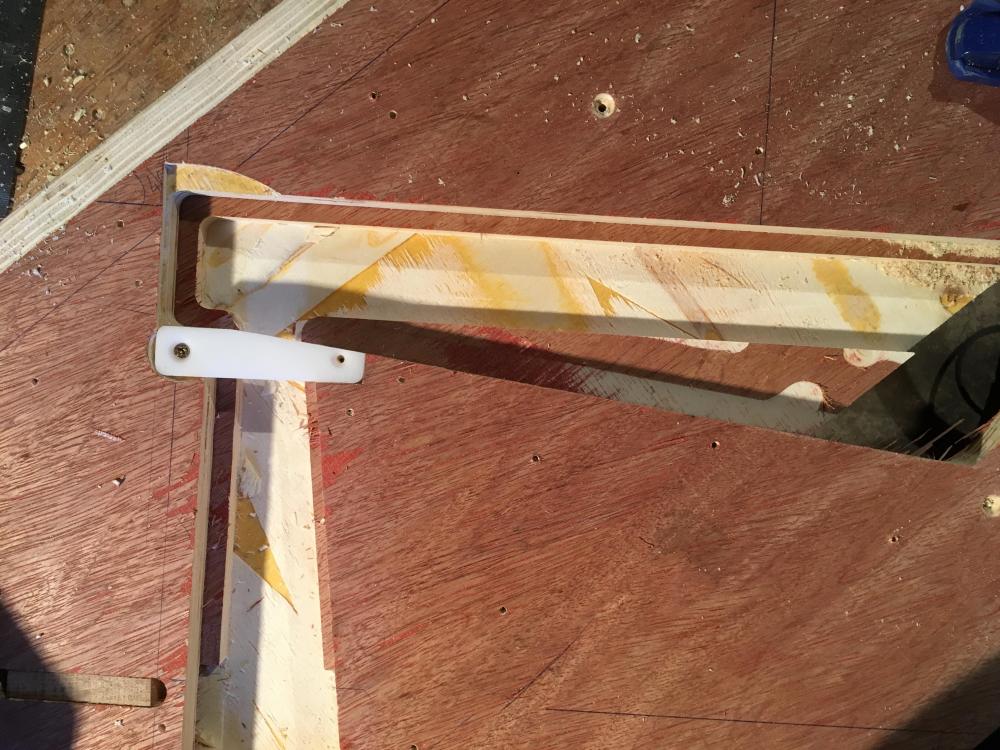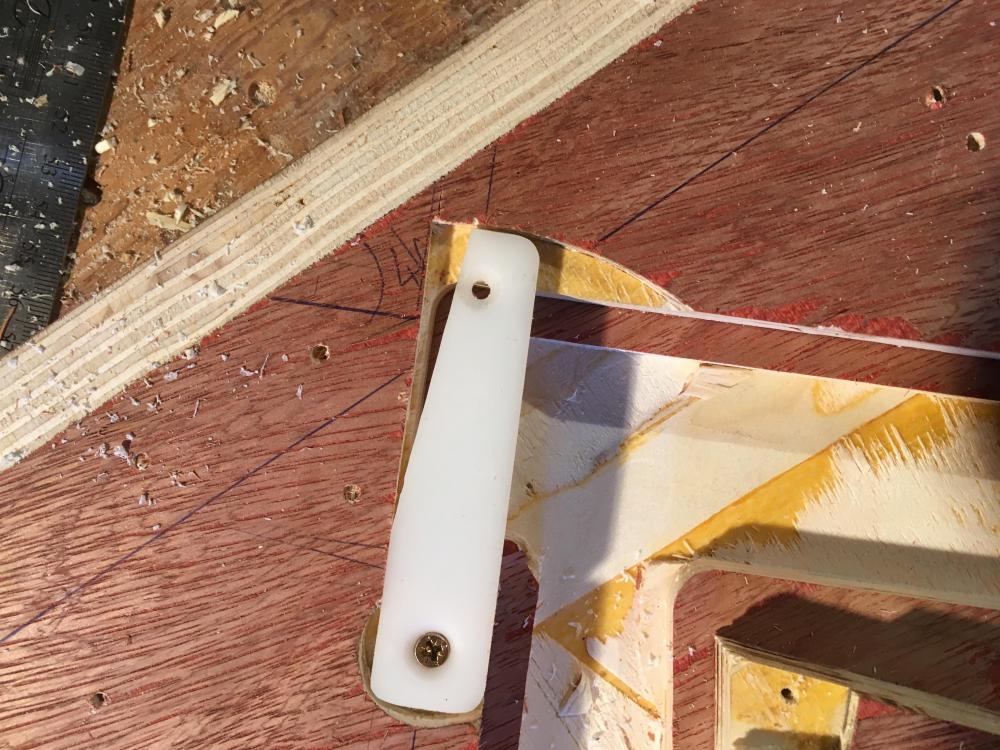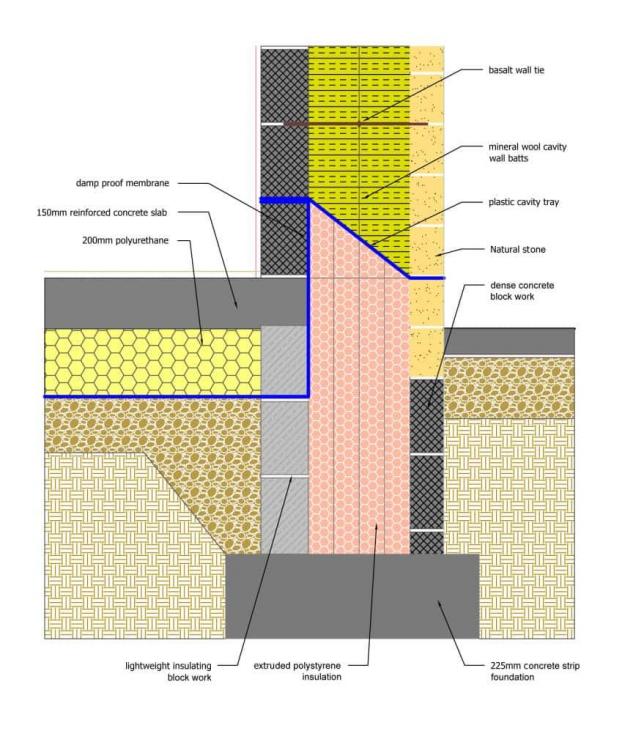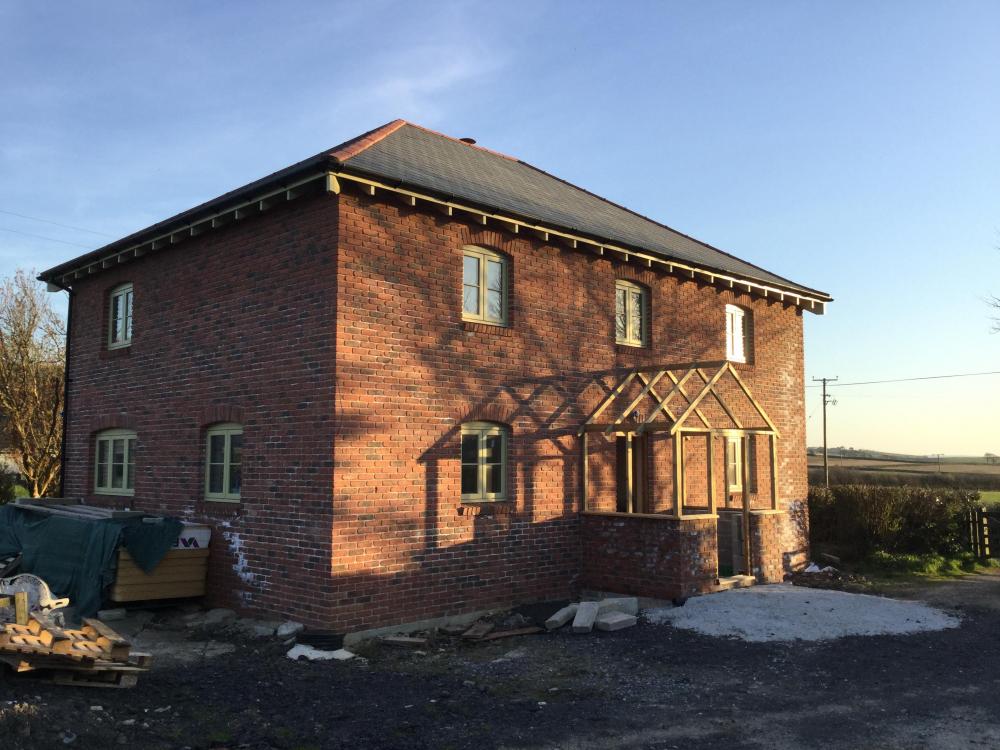Leaderboard
Popular Content
Showing content with the highest reputation on 06/18/18 in all areas
-
Just got to scrape the hardended gun foam off the big st/st trowel and derust the other one...4 points
-
Well. After a year of negotiating on a plot and trying to meet the many challenges it presented, we have, at the eleventh hour, reconsidered. No plot purchase, no build. We'll still be selling up and downsizing, but no fixed plans after that. There might yet be a future project, but there's nothing in mind at the moment. Thanks for all your support and advice. Might still drop by on occasions, meanwhile... Au revoir Dee3 points
-
Cheers for the support Ed. Of course the doubters are the sort who'd probably buy their own stairs!3 points
-
As I understand it, most oak frame/SIPs combinations now have the oak frame inside and the panels wrapped around the outside of it to avoid cold bridging through the oak. The thing is, SIPs are themselves a structural option, which makes the oak frame largely redundant. If you do follow this route, then I would suggest thinking exactly where in the house you actually want to be able to see the oak - it may for instance be possible to work some oak timbers into the structure of a timber-framed building without needing an entire oak frame, saving £££££. More importantly, if the SIPs are on the outside then the only real limitation on thickness is the internal and external dimensions of the building. That means any insulation level up to Passivhaus is possible with a full structural timber frame - see https://www.oakwrights.co.uk/siteI/cfbc0416c099a39a8bd816131025b2d8/press/39935ffd63b49558c7873a6fea6f430e.pdf - but the best way of doing it may not necessarily be with SIPs (the couple in that example didn't use them, for instance). If I'm understanding things correctly, the UK building regulations at the moment should limit consumption to about 50 kWh/m2/year for space heating - about 9,000 kWh/year for your proposed buildings. For comparison Passivhaus is defined at 15 KWh/m2/year with a rather more rigorous modelling system to back it up - about a 70% saving over building regulations even before you start looking at heat pumps. By the time the heat demand gets that low even electric resistance heating (which is really cheap to install) is economical to run. Don't feel forced to go down the heat pump route - I happen to think it's a pretty good one, but the better insulated your house the better it works. If you're planning on only meeting the minimum PP target, then I would think seriously about alternatives like LPG or Oil: they're well understood, cheap to install and deal well with increasing the output temperature a bit because say your radiators were a bit too small. Personally I think heat pumps are the best solution for a low-energy house, which is why I want to go down that route, but don't make the assumption that they're the best option for every house. Good performance is critically dependent on them supplying heat at a low temperature - the worse the insulation, the harder this is to actually achieve. Assuming total annual consumption is about 14 MWh (plug loads, hot water, etc.) then you need about 1.5 MWh/year from PV to meet the PP specification. As a rule of thumb, a 1kW panel facing south in the UK will give about 1 MWh/year of generation - so you could meet it with a 6 x 250W panel system costing maybe £2k for a ground-mount system. That's almost certainly the cheapest way to meet the target, and will be why the PP suggested it. I would suggest taking a step back and thinking through (in order): What your energy target is going to be - the minimum to meet PP, minimum cost to live in afterwards, or something else. This will define the insulation levels in the structure, which will make clear what else is practicable. If you want to have a play with that, @JSHarris has written a pretty decent heat loss calculator at http://www.mayfly.eu/wp-content/uploads/2017/01/Fabric-and-ventilation-heat-loss-calculator-Master.xls When you know this, work out how you want to deliver the heat - radiators, underfloor heating, warm air, something else? Underfloor will work with just about anything, but warm air and radiators don't play well with heat pumps. Then you can do a meaningful trade-off between ASHP, GSHP, electric resistance, LPG, etc. - knowing the annual heat consumption and peak heating load is critical here because it changes the design of a heat pump system radically, while a traditional boiler system really doesn't change a lot. If you want building regs minimum and radiators, then you should probably look at LPG or oil - you need quite a bit of heat delivered at a high temperature. Building regs minimum plus underfloor might well be the sweet spot for a GSHP as demand will be high enough for the COP gain to be worthwhile. It's worth running some calculations on this though - the SCOP figures published by the manufacturers should be good enough for this, divide heat load by SCOP to give electrical consumption and work out if it ever pays back over an ASHP. If you want Passivhaus or close to it - particularly with underfloor heating - then you should probably look at an ASHP like @jack as the heat load will be so small that there is no point to a GSHP. Resistance heating is feasible at this point, however, and gives you low installation cost with bombproof reliability: at 15 kWh/m2/year and 15p/kWh then your heating bill for a 180m2 house is only going to be £400. @TerryE has gone down this route and it has worked very well for him. When you've done all that, then is the time to think about renewables (PV, realistically) - more insulation or underfloor heating is an utter nightmare to add by retrofitting, while a ground-mount PV system is incredibly easy. Make sure you've got the things that are locked in done early, and worry about the rest later.3 points
-
The red bit on the handle is unicorn horn And you don’t really need one, work from the corners and just use a wet brush down the inner corner to clean it off2 points
-
2 points
-
Beer before wine makes you feel fine, wine before beer makes you feel queer ?2 points
-
Tracking systems have the panels fitted to a moveable mount so that the panels are always perpendicular to th esun; they follow the sun through the course of the day. A tracker system will give about 30% more output for a given array than a fixed system. Against that you need an extremely robust tracking mechanism which is going to be expensive. If you have the room it's generally cheaper to have a bigger array than a tracking system. Placement just means that you put your panels in a place that has the most clear view of the sun with no shadows from trees or buildings. Shading reduces PV output enormously.2 points
-
This would have been better as a 1.5 storey cottage. Much more in keeping with the local vernacular.2 points
-
Two man lift and the cover comes off! They then get to experience a fully sunken bath.1 point
-
No I am skipping this and hoping the newbuild really is my "forever house". Cannot believe I am using such a cutesie term, I must be watching too many TV property programs.1 point
-
I might be giving off procrastination vibes so timely advice. Things are happening behind the scenes: The foundation digger man is booked. Concrete ordered dig + 2 days. Got an even lower price on the concrete because wise old owl builder says the concrete wagon will have no problem on my now very firm green field hence no need for pumpable stuff. Concrete supplier is going to pop around and double check ground condition. Wise old owl semi retired builder is loaning me his £600 laser for the setting out levels levels. Meeting building control inspector on site this Thursday. Now I have time to speculate what happens above dpc.1 point
-
So I put the metalwork away for another day and decided to have a crack at taping and filling the joints. Someone said if you don't they'll show through. But first I scraped off some nasty blue stuff that I thought might make things a bit gritty... I've about 4.9L left if anyone wants it... I put 5:1 pva through a garden sprayer. I'm sticky from head to toe. Now I know how @pocster must feel 24/7! It was OK on the two wall joints but it dripped from the ceiling. A bit of kitchen roll and some dabbing soon sorted things. I let the pva go tacky and whacked some in the te joints. The short joint to the right of the body dryer where the spot hole is, is I think a butt joint, so it'll be interesting to see how that comes out: Where the Febond Blue Grit had been was a little awkward, it went "liney": But I let it go off and went back and flatted it off (flatting being a term we plasterers use ). Bottom line is I'm not scared of it! Reckon just doing that little bit that my right arm will ache in the morning. A feeling many on this thread I'm sure are familiar with!1 point
-
That all depends who plumbs it and what valves they use. I prefer separate 2 port valves and this programmer will do fine, there are other 3 channel programmers around but not many.1 point
-
1 point
-
If you have to have an Aga - they are really a lifestyle statement in a well insulated house - then look at the ones from EcoRange as they can be timed much better and run less. It also tells you on their website how much heat into the room they create - you just deduct this from the heat requirement of the room and factor that into your UFH plan.1 point
-
Hot Return Circuit. The pump you have that ( when fitted correctly ) massively reduces the delay in getting hot water out of any outlet.1 point
-
anytime. and good on you for standing by your decision, the bit that's amusing me is that everyone is just assuming you BIL is actually a "good" plasterer. (not that I'm saying he isn't, but I know "professional" plasterers that I wouldn't let ice a cake let alone have a go at my walls) as for making the stairs, i have got a cunning plan how to get over my issue, its so cunning if it works it might be worth looking into patents....... I wont but in my head it is going to work really rather well....1 point
-
It makes no sense at all to have a CO detector in a house that has no combustion devices, as that's the only source of CO in a house. Makes more sense to have a CO2 sensor, as that's a pretty good indicator of general air quality indoors, I've found. When I measured CO2 levels in our old house I found an explanation as to why our bedroom always seemed to feel stuffy, despite a small window always being open. The CO2 level was increasing to around 1,600 ppm in the early hours of the morning, only dropping when we got up and opened the bedroom door. Opening the door quickly dropped the CO2 concentration, as it allowed through ventilation. I've no doubt that window ventilators would be just as useless as leaving a small window open, as long as the door is closed. It probably explains why houses with MVHR always seem to feel much fresher.1 point
-
1 point
-
I think the fact that I have no idea what you’re on about is probably a good thing at this point What’s an HRC?1 point
-
remember to take plenty of pics to remember the occasion!1 point
-
Rumsfeld on unknown unknowns. Reports that say that something hasn't happened are always interesting to me, because as we know, there are known knowns; there are things we know we know. We also know there are known unknowns; that is to say we know there are some things we do not know. But there are also unknown unknowns – the ones we don't know we don't know. And if one looks throughout the history of our country and other free countries, it is the latter category that tend to be the difficult ones Best of luck.1 point
-
is there anything stopping you glueing battens to the roof with industrial strength glue? eg https://www.diy.com/departments/evo-stik-serious-stuff-solvent-free-grab-adhesive-0-29l/212376_BQ.prd Or clamp battens at the sides of the roof and attach to those?1 point
-
Picking up my 30L plasterers bucket up from Screweys on the way home!1 point
-
For info, these are the AICO units I used: https://www.tlc-direct.co.uk/Manufacturers/Aico/Smoke_Alarms_Mains_Alkaline/index.html Not expensive, and dead easy to unclip from the base to change the backup battery. You can also use a lithium PP3 backup battery, rather than an alkaline one, that increases the battery shelf life a fair bit.1 point
-
They should have a maunfacturing date somewhere. That site does not say WHEN the Firex brand was discontinued, just that Kidde took over he brand in 2009 and it is now discontinued, so it might have only been last year that they were discontinued and they might still have been current?1 point
-
Buy a decent make like AICO. They are not that expensive if you search on line, and there is no issue replacing a failed or time expired unit. Apart from anything else, AICO are one of only a few with decent back plates and decent electrical terminations.1 point
-
1 point
-
1 point
-
1 point
-
Well pdf 27, you obviously know your stuff, so glad I joined this forum. I have some homework to do now!1 point
-
1 point
-
First he'll need to plant the hazel seeds, manufacture the necessary tools , dig up some limestone, build a crusher, build a kiln, etc. We may be some time.1 point
-
1 point
-
They also are a doddle for DIY non-MCS registered installs ( e.g. cheap ) so look at what you need and aim to self-consume all, or as much of, what you generate. If you have electric only, then I'd look at a Sunamp + Willis ( immersion heater ) based UFH system with a second Sunamp as the DHW ( domestic hot water ) provider. Look to store as much of the pv generation as you can by employing a good pv diverter and once you've got a year under your belt, if necessary, you could add a few more panels if so required. Id forget oil or lpg and put the cash into something smarter. An ashp would be a cheap way to solve space heating but when you need it most, the pv won't really be up to providing what you need anyway so £'s per kW ( taking maintenance and lifespan ) the Sunamp + Willis solution has the most appeal imo. That lot fortified with grid electricity for any time the pv hasn't cut it and you've got a clean, simple, and uber-low maintenance solution.1 point
-
I love those sorts of statement..!! 10% of what..??! If you replaced all of your lights with LED from CFL you would easily make 10% but it’s meaningless for a new build.... Ground mount PV lend themselves to tracking systems so think about placement and exposure.1 point
-
It's like CAD come to life! ? A few cable ties wouldn't go amiss...just make sure you get them all the same way around...1 point
-
As per Steamy,s post above, yes our site is very flat, thick yellow clay and very boggy. The local building control guy was happy with trench foundations and asked for 800mm deep and 700mm wide ( our walls are brick and block outer and inner with 200mm full fill cavity with Rockwool ) we installed a French drain around these (back-filled the trench outside with 50mm stone) and piped it to a local ditch. The foundation detail was as follows to avoid cold bridges and I am very happy with it, we did not need an SE to design or sign it off..You mentioned “cottage”, ours too is cottage P.s. we also have a DIY installed ASHP ( which I have yet to fire up).1 point
-
1 point
-
1 point
-
I think he should go outside and cut some nice hazel and hand split it then replace all this nasty board with some nice lath .... Then lime plaster it, horsehair in the backing coat of course ......1 point
-
After youve spunked all your cash on the various potions, and devices with which to apply them, your have paid the spread. A 4' blade needs some serious skill, and I just about have the wrists for my 18" Ox for flattening off over old plaster etc. No xmas card for you this December ! Dead man walking The last customer who said exactly that asked to borrow my step ladder to skim his bathroom ceiling. When I came in the following morning, the ceiling was destroyed, his clothes were rolled up in the corner covered in plaster and about 8 litres of sweat, and my lightweight aluminium step ladder had to go in the skip as it weighed about 60kg with all the plaster that was on it. Took about 4 hours to clean the floor and walls too. My mate came in that evening and skimmed it for £80. Was like a sheet of glass. Disclaimer : After all this has been said, I really need you to cock it up or I'm going to put 2 stone on from all the humble pie and custard.1 point
-
I'm looking for openness and answers to simple questions, @PeterW. You know me: I'm an early adopter and have no real problem buying 'non traditional' products (for example Durisol). I agree wholeheartedly, Nulok does look very good. Anything that moves the sector on a place or two has to be good, but I also agree that most want to build as they've always built before. The current importer has been asked for customer references: an attempt at an answer was made, but no customer reference was given. A small deposit on a Credit Card covers the whole transaction, I understand. 4.5% of £1000 is nowt. For all I care his company can add the £45.0 to the total price if it's a concern.1 point
-
The answer to that (at least I have found from my tiny plastic tool storage shed) is to leave nothing but crap in it for the first few months. Secure it with something that won't damage the container when it is removed wrongly. Find it open once or twice a week for a month or so. Then another couple of times over the next 6 months, you could then leave the crown jewels in there. (Admittedly it's not big enough to store more than a few basic garden tools and bird feed) But, after the first 6 months, it hasn't been touched for about 6 years or more now.1 point
-
To be honest, it depends very much on the usage patterns and house design, and it also varies tremendously by season. We have a 3 person household, 2 retired and one live-in adult son effectively in his own flatlet in our loft. Ours is a passive-class new build electric only, and no PV because of planning restrictions. Our current daily energy bill is around £2.10 but a reasonable chunk of this is my son's 2×PC + 2×TVs. In the depths of winter it might get up to £6.50 if it is freezing outside, but we have no maintenance costs as we have no equipment like gas boilers or ASHPs that need annual service contracts.1 point
-
Let me take my time thinking of a response...1 point
-
For 5 ensuites...??? ? I'm assuming we are talking a 750 or 1000 litre TS here..? With a 60-70kw DHW coil or PHE..?? And all the joy of a TS with a HRC.... hmm.... flow switch and pump anyone..?? @newhome...?0 points
-
0 points








.jpg.c21f3ac78c9b7efd90cbdcb312744dc5.thumb.jpg.7adcad4c0e384f5ecd7d56b0618df6e5.jpg)






